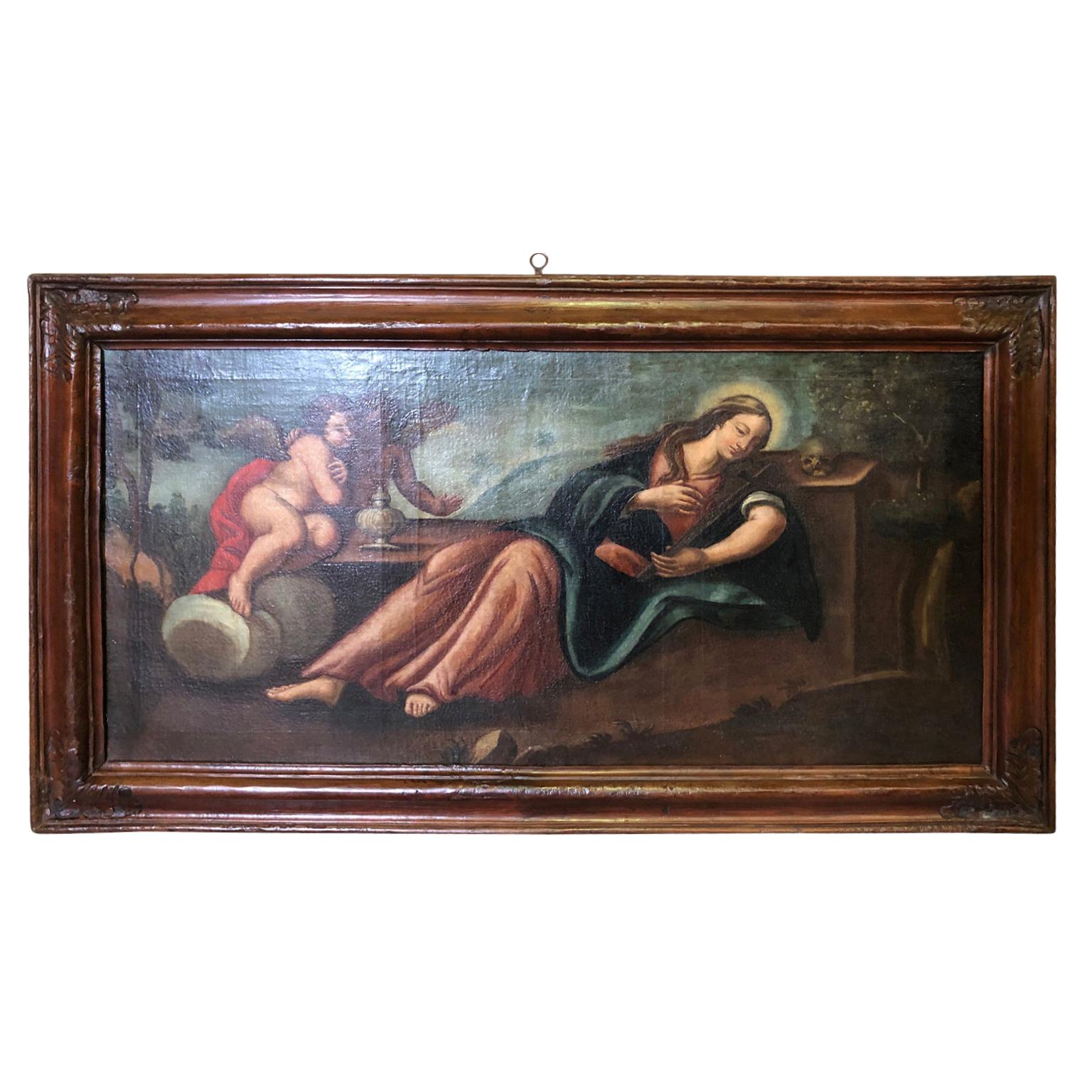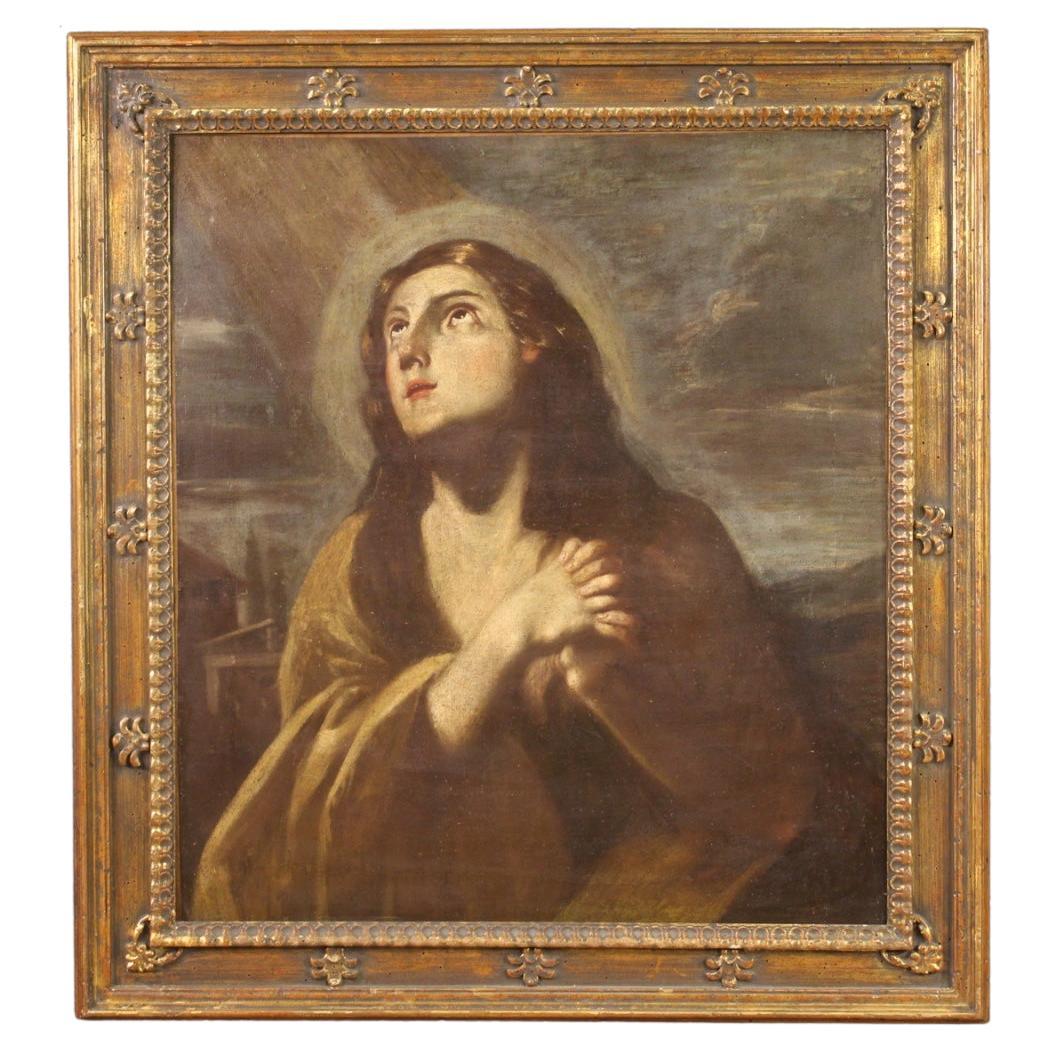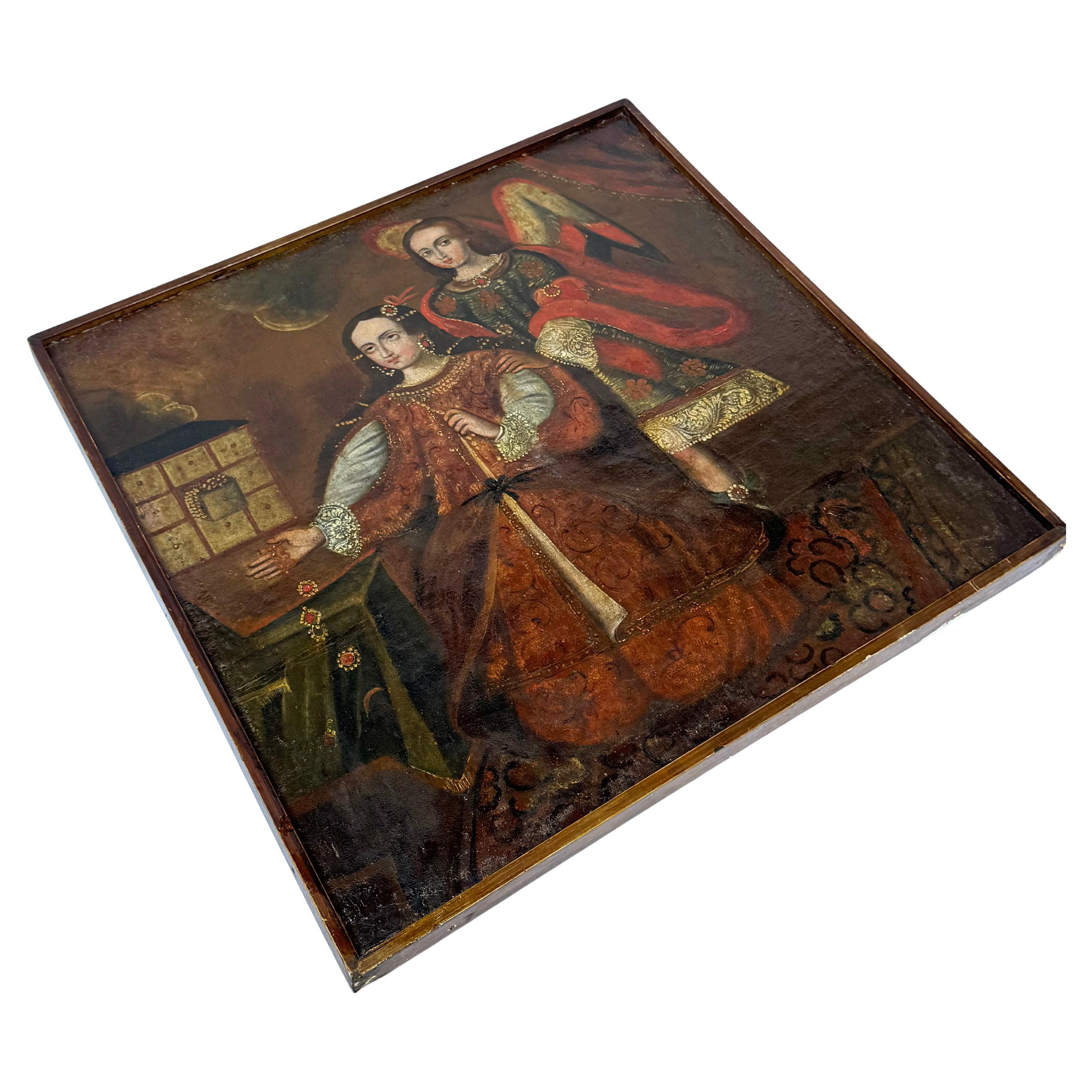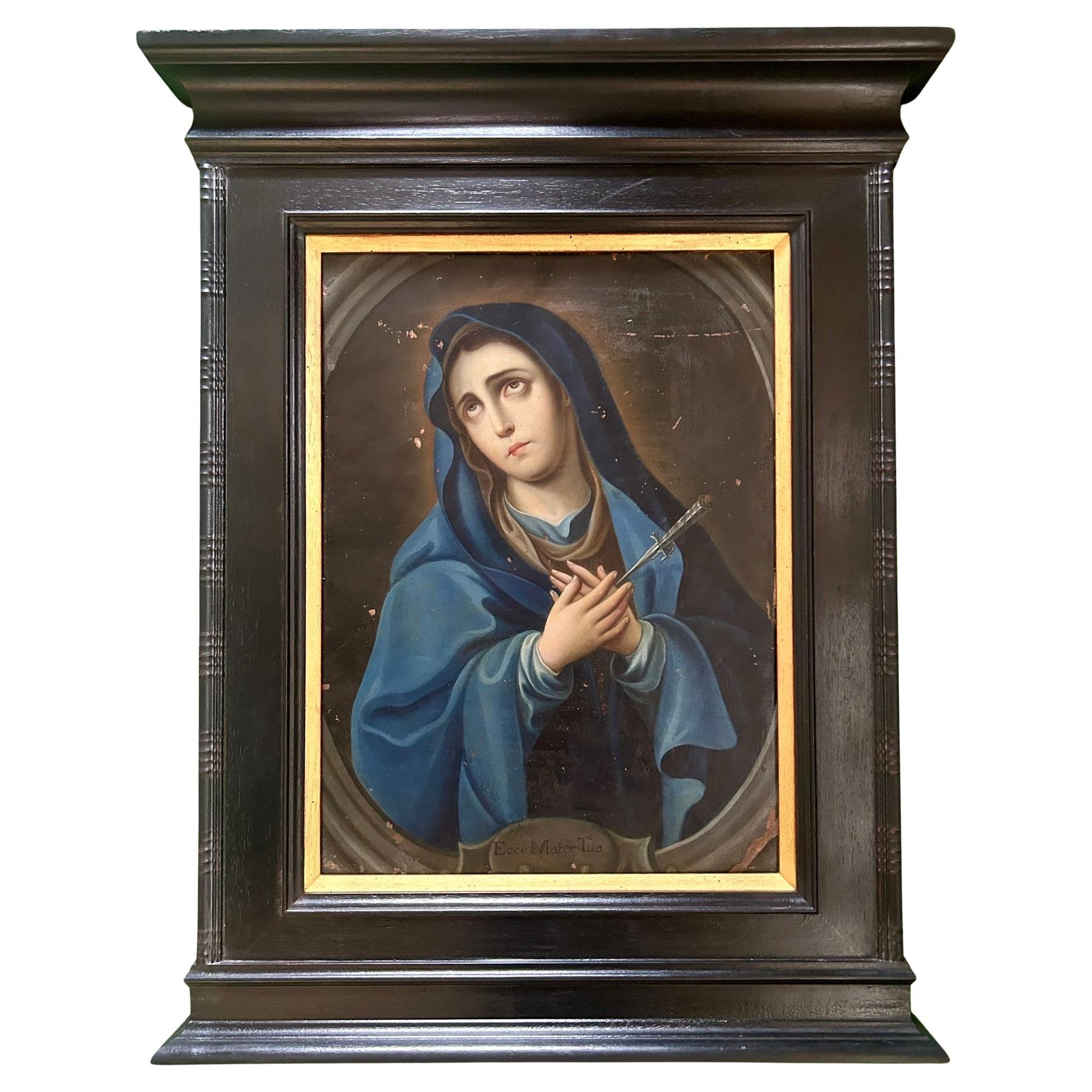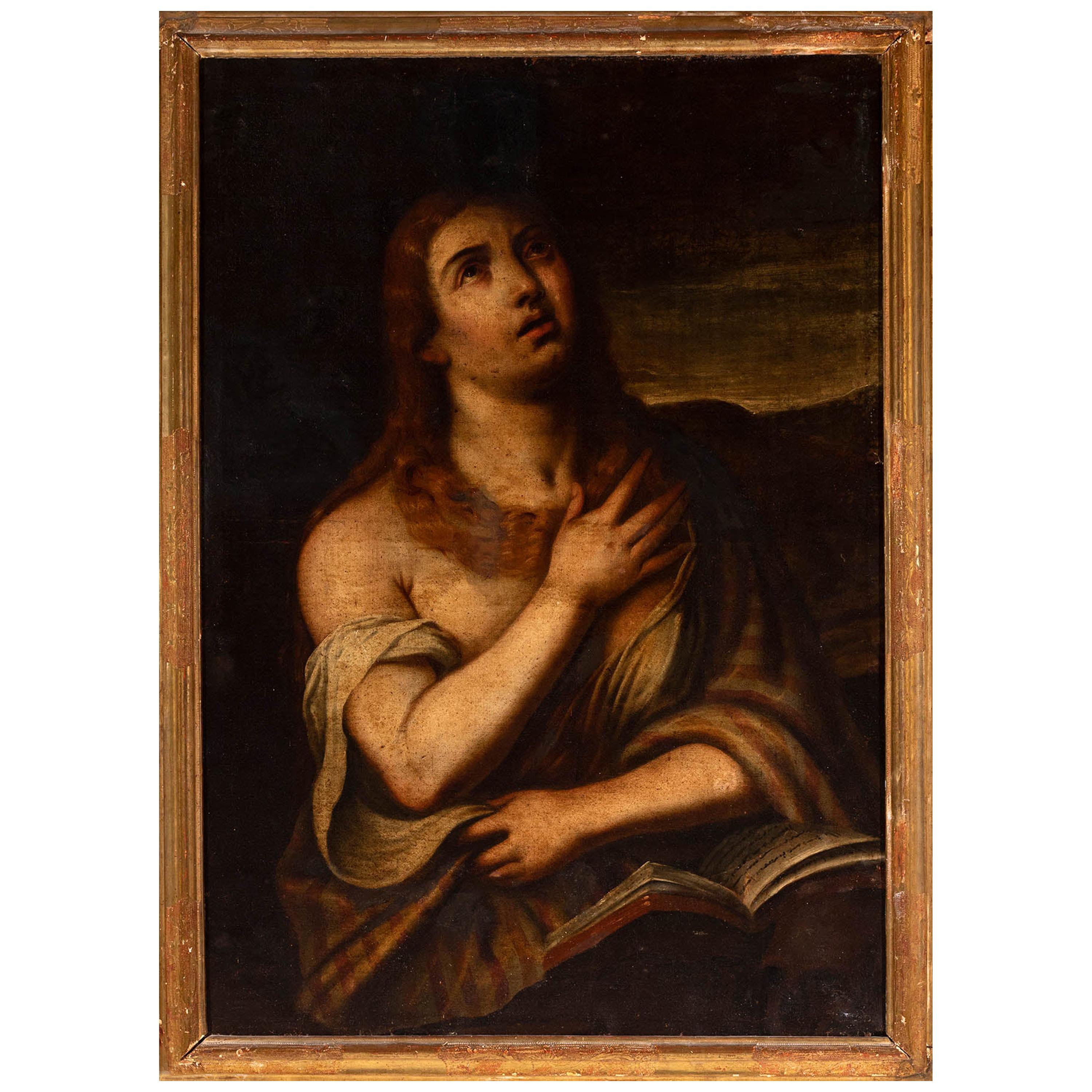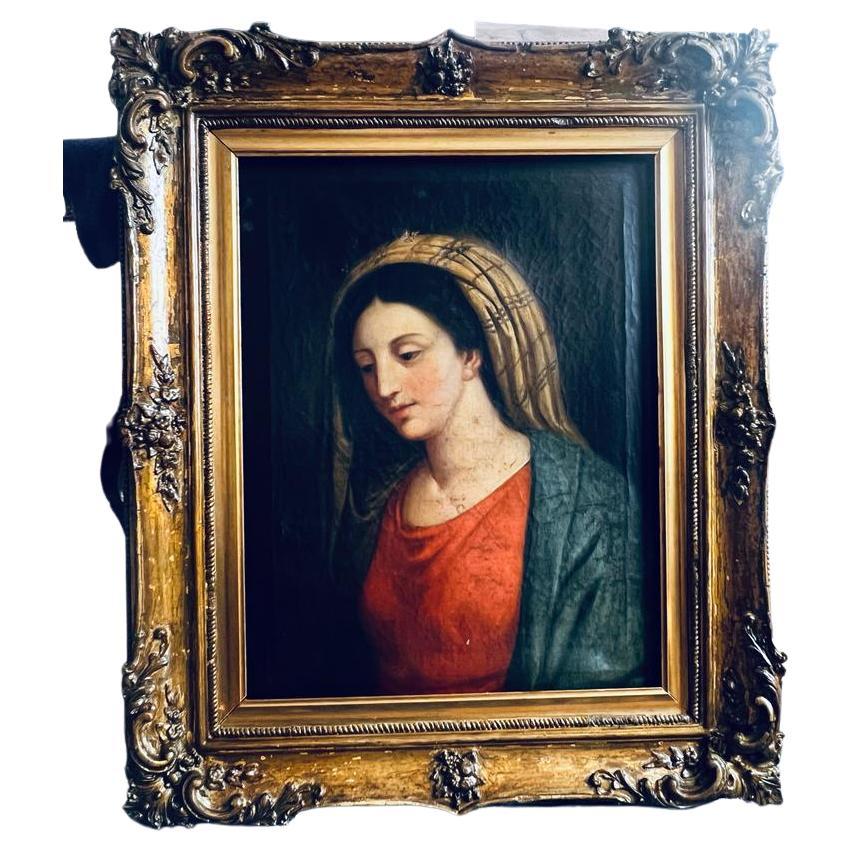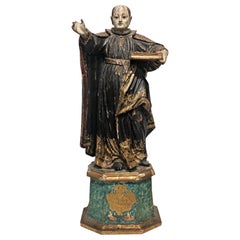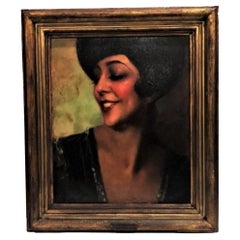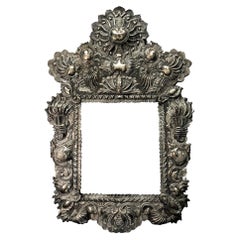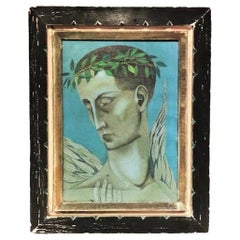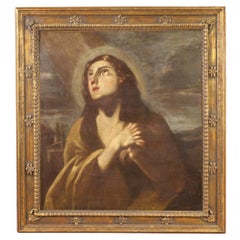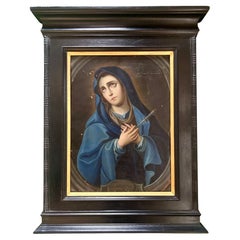Items Similar to Spanish Colonial, Penitent Mary Magdalene, Original O/C Painting, 18th Century
Want more images or videos?
Request additional images or videos from the seller
1 of 8
Spanish Colonial, Penitent Mary Magdalene, Original O/C Painting, 18th Century
$4,500
£3,414.50
€3,904.17
CA$6,285.28
A$6,988.38
CHF 3,648.94
MX$85,065.55
NOK 46,558.94
SEK 43,623.50
DKK 29,137.55
Shipping
Retrieving quote...The 1stDibs Promise:
Authenticity Guarantee,
Money-Back Guarantee,
24-Hour Cancellation
About the Item
Spanish Colonial
Penitent Mary Magdalene
Original oil on canvas painting
XIX century
Details
Original period frame.
Painting dimensions
Height: 11.25 inches
Width: 9-1/8 inches
Depth: 1.5 inches
Frame dimensions
Width: 3.25 inches.
- Dimensions:Height: 11.25 in (28.58 cm)Width: 9.13 in (23.2 cm)Depth: 1.5 in (3.81 cm)
- Style:Spanish Colonial (Of the Period)
- Materials and Techniques:
- Place of Origin:
- Period:
- Date of Manufacture:18th Century
- Condition:Wear consistent with age and use. We make our best effort to provide a fair and descriptive condition report. Please examine photos attentively, as they are an integral part of the description. Send us a message to request more details or discuss price.
- Seller Location:New York, NY
- Reference Number:1stDibs: LU2819330254262
About the Seller
5.0
Vetted Professional Seller
Every seller passes strict standards for authenticity and reliability
Established in 1993
1stDibs seller since 2017
83 sales on 1stDibs
Typical response time: 11 hours
- ShippingRetrieving quote...Shipping from: New York, NY
- Return Policy
Authenticity Guarantee
In the unlikely event there’s an issue with an item’s authenticity, contact us within 1 year for a full refund. DetailsMoney-Back Guarantee
If your item is not as described, is damaged in transit, or does not arrive, contact us within 7 days for a full refund. Details24-Hour Cancellation
You have a 24-hour grace period in which to reconsider your purchase, with no questions asked.Vetted Professional Sellers
Our world-class sellers must adhere to strict standards for service and quality, maintaining the integrity of our listings.Price-Match Guarantee
If you find that a seller listed the same item for a lower price elsewhere, we’ll match it.Trusted Global Delivery
Our best-in-class carrier network provides specialized shipping options worldwide, including custom delivery.More From This Seller
View AllAfter Francisco Ruiz Gijon, St. Francis, Spanish Baroque Wood Sculpture, 17th C.
Located in New York, NY
Baroque
After Francisco Ruiz Gijon
Saint Francis of Assisi
Polychrome and Parcel Gilt Carved Wood, Insert Glass Eyes
Spain, Late 17th Century
Francisc...
Category
Antique 17th Century Spanish Baroque Figurative Sculptures
Materials
Glass, Wood
Emmanuel Fougerat, O/C Portrait of La Argentinita, ca. 1920
By Emmanuel Fougerat
Located in New York, NY
DIMENSIONS:
Height: 16.25 inches
Width: 13.5 inches
Depth: 2.25 inches
Frame width: 2.5 inches
ABOUT MODEL
Encarnación López Júlvez, known as La Argentinita (Buenos Aires, March 3, 1898 – New York, September 24, 1945) was a Spanish-Argentine flamenco dancer (bailaora), choreographer and singer. La Argentinita was considered the highest expression of this art form during that time.
López Júlvez was the daughter of Spanish immigrants in Argentina, where her father had a fabric business. While living there, two of her siblings died in a scarlet fever epidemic. Consequently, she was brought to the north coast of Spain in 1901, where she began to learn Spanish regional dances.
When she was only four years old, she started learning flamenco from Julia Castelao. Her first public performance was at the age of eight at the Teatro-Circo de San Sebastián, in the Basque Country. She chose the name "La Argentinita" in deference to the famous flamenco dancer Antonia Mercé (La Argentina).
After travelling throughout Spain as a child prodigy, she settled in Madrid to perform at Teatro La Latina, Teatro de la Comedia, Teatro de La Princesa, Teatro Apolo and Teatro Príncipe Alfonso. Her success led her to tour in Barcelona, Portugal and Paris, and then Latin America.
In the early 1920s, she returned to Spain, where she worked in Madrid. Among her early performances was the 1920 premiere of Federico García Lorca's musical play El maleficio de la mariposa as "the Butterfly". She announced her retirement in 1926, but would quickly return to the show business as part of the artistic renewal that led her to the Generation of ‘27, in which she combined flamenco, tango, bulerías and boleros. She danced to the compositions of Manuel de Falla, Joaquín Turina, Isaac Albéniz, Enrique Granados and Maurice Ravel. She helped in the development of Ballet Español.
Adapting pieces to popular tradition, she toured Europe, triumphing in Paris and Berlin and participating in the artistic movements of that time along with Spanish poets such as Rafael Alberti, Federico García Lorca, Edgar Neville and Ignacio Sanchez Mejias. Sánchez Mejías, an intellectual and bullfighter, was a married man and her lover. La Argentinita retired a second time to maintain her clandestine relationship with him. However, she would return to the stage with the aid of Sánchez Mejías, who participated in the search and employment of interpreters for her subsequent performances.
In 1931, López Júlvez and García Lorca recorded five gramophone slate records, which were accompanied by García Lorca's piano. The selection of songs was prepared, adapted and titled Colección de Canciones Populares Españolas by García Lorca. Among the ten songs were "Los cuatro muleros", "Zorongo gitano", "Anda Jaleo" and "En el Café de Chinitas".
With the beginning of the Second Spanish Republic, López Júlvez formed her own ballet company called Bailes Españoles de la Argentinita together with her sister, Pilar López Júlvez, and García Lorca. López Júlvez staged several flamenco theatrical shows, including an adaption of Falla's El amor brujo (Love, the Magician) in 1933, and Las Calles de Cádiz (The Streets of Cadiz) in 1933 and 1940.[7] She travelled through Spain and Paris, where she was recognized as one of the most important flamenco artists of her time. Her company included the flamenco figures Juana la Macarrona, La Malena, Fernanda Antúnez, Rafael Ortega and Antonio de Triana, who was her first dancing partner until the 1940s.
At the end of her tour around Spain, her lover Sánchez Mejías was gored to death in 1934 in the Manzanares bullring. She sought refuge in her work and moved to Buenos Aires to dance at the Teatro Colón; from there she embarked on a long American tour. In 1936 she achieved success in New York. Afterwards, she returned to Spain but was forced to flee the country shortly before the outbreak of the Spanish Civil War. She travelled through Morocco, France, the UK, the Netherlands, Belgium and the USA, where she remained in exile in New York. From then until her death in 1945, she developed her career and became one of the biggest stars of international dance, and even participated in movies.
In 1943, she presented the flamenco troupe El Café de Chinitas at the Metropolitan Opera House in New York, with her own choreography, texts by García Lorca, scenery by Salvador Dalí and the orchestra directed by José Iturbi. In addition, she performed at the Washington DC Watergate complex with her sister.
On May 28, 1945, she gave her last performance at the Metropolitan of the orchestral work El Capricho Español, composed in 1887 by Nikolai Rimsky-Korsakov and based on Spanish melodies. At the end of the event, she had to be admitted to a hospital, where she died on September 24 from a tumor in her abdomen. She did not want to have it operated on because she did not wish to abandon dancing. Her body was repatriated to Spain in December and buried in the Spanish capital. That same year, the company of Bailes Españoles de la Argentinita was dissolved.
Among the honors she received after her death was a plaque consecrated at the Metropolitan Opera House, positioned among the medals of Alfonso X El Sabio and La Orden de Isabel la Católica to honor her merits in the field of culture.
ABOUT ARTIST
Emmanuel Fougerat (French, 1869 – 1958) was a renowned French painter, museum curator and art historian. A former student of the Regional School of Fine Arts in Rennes, Fougerat studied in the studio of Albert Maignan and that of Jean-Paul Laurens in Paris.
He was appointed director of the Nantes School of Fine Arts and was also the founder and curator of the Museum of Fine Arts in the same city. Emmanuel Fougerat was named Chevalier of the Legion of Honor in 1912. In 1923, he was placed on temporary leave from the French State in order to carry out a mandate as director of fine arts education in the Province of Quebec, Canada; where he served as an art teacher and director of the École des beaux-arts de Montréal from 1923 to 1925.
Emmanuel Fougerat’s paintings are in the following public collections:
• Nantes Museum of Fine Arts, France.
• Museum of Modern Art in Paris, France.
• Rennes Town Hall: permanent decorations.
• Museum of Fine Arts of Saint-Nazaire (destroyed in 1944), France
• National Museum of Fine Arts of Quebec, Canada.
Emmanuel Fougerat is also the author of works on several French painters, including Albert Besnard, Paul Baudry...
Category
Vintage 1920s French Art Deco Paintings
Materials
Canvas
Spanish Baroque Repoussé Silver Mirror/Picture Frame, XVII C.
Located in New York, NY
ABOUT FRAME
Handmade during 17th century, this frame is a grandiose piece of master craft by an extraordinary Spanish silversmith. Exceptionally complex, not only in its exquisite an...
Category
Antique 1670s Spanish Baroque Picture Frames
Materials
Silver
Richard Wilt, Caesar, American Mid-Century Modern O/C Painting, Ca. 1960s
By Richard Wilt
Located in New York, NY
ABOUT ARTIST
Richard Wilt (American, 1915 - 1981) > Chronology and Exhibition History
1915 Born in Tyrone, PA
1981 Died in Ann Arbor, MI
EDUCATION:
1...
Category
Vintage 1960s American Mid-Century Modern Paintings
Materials
Canvas
Bernard Taurelle, Nu, French Modernist Oil on Canvas Painting, circa 1960s
By Bernard Taurelle
Located in New York, NY
Signed lower right corner.
Stamped en verso Galerie Felix Vercel Paris - New York.
Original period frame.
Bernard Taurelle (French, B. 1931) is a famous French artist, widely known ...
Category
Vintage 1960s French Post-Modern Paintings
Materials
Canvas
Karoly Fulop, The Baptism, Polychromed Ceramic Panel, circa 1950s
By Karoly Fulop 1
Located in New York, NY
Karoly Fulop (Hungarian, 1893-1963.) 'The Baptism' polychrome glazed ceramic signed to reverse 28" H x 24" W x 1.5" D A framed polychromed Art Deco ceramic panel, by multi-media arti...
Category
Mid-20th Century Hungarian Modern Paintings
Materials
Ceramic, Wood
$3,375 Sale Price
25% Off
You May Also Like
18th Century Spanish Oil Painting of Mary Magdalene
Located in Round Top, TX
A breathtaking 18th century Spanish oil on canvas painting of Mary Magdalene - Madeleine - in is original frame. Beautiful detail.
Category
Antique Mid-18th Century Spanish Paintings
Materials
Canvas
17th Century Oil on Canvas Antique Religious Italian Painting Magdalene, 1680
Located in Vicoforte, Piedmont
Antique Italian painting from the second half of the 17th century. Artwork oil on canvas depicting a religious subject Penitent Magdalene of excellent pictorial quality. Large size p...
Category
Antique 1680s Italian Paintings
Materials
Canvas
$6,235 Sale Price
20% Off
Free Shipping
Saint Mary Magdalene - Spanish Colonial - 18th Century
Located in Rio De Janeiro, BR
An exquisite Spanish Colonial oil painting from the 18th century, depicting Saint Mary Magdalene in a richly detailed composition. This piece showcases the characteristic Cuzco Schoo...
Category
Antique Mid-18th Century Bolivian Spanish Colonial Paintings
Materials
Canvas
18th Century Spanish Colonial Mater Dolorosa (Our Lady of Sorrows) Oil Painting
Located in London, GB
18th Century Mater Dolorosa Religious Oil Painting, Antique Spanish Colonial Religious Oil Painting, Our Lady of Sorrows Painting, Antique Religious Oil Painting...
Category
Antique Late 18th Century Mexican Spanish Colonial Paintings
Materials
Copper
18th Century Spanish "Penitent Magdalene" Oil on Canvas Following Tiziano
Located in Marbella, ES
18th century Spanish "Penitent Magdalene" oil on canvas in the style of 17th century Italian school, particularly Tiziano models.
Dimension: 101 x 71 cm, 111 x 80 cm (frame).
Category
Antique 17th Century Italian Paintings
Materials
Canvas
Antique 17th Century Painting Madonna /Virgin Mary Italy Oil on Canvas
Located in Doha, QA
Magnificent Italian 17th century Portrait of Virgin Mary measures 52 x 68 cm without the frame.
The colors are stunning and the paintin...
Category
Antique 17th Century Italian Baroque Paintings
Materials
Canvas
More Ways To Browse
Spanish Colonial 18th C Furniture
Francis Woodahl
Francois Alfred Delobbe
Frank Leonard Brooks
Franklin Carmichael
Fred Hines Painting
Frederic Montenard
Frederick Terna
Fritz Von Uhde
Gaylord Flory
Geoffrey Chatten
George Carlson
George Forgie
George Lambdin
George Oberteuffer
George Samerjan
Golden Retriever Painting
Gordon Eastcott Payne
